SUBSCRIBE TO DR. WALTER SALUBRO’S YOUTUBE CHANNEL
Read below for the full video transcript.
In this video, I am going to show you how to decompress your full back and show you what happens when you decompress your spine. Watch this video right to the end, because it will show three exercises to decompress your full back without using heavy equipment After each individual exercise, I am going to explain exactly what it is doing to the spine during that decompression exercise. Hi, I’m Dr. Walter Salubro, a chiropractor in Vaughan, Ontario, Canada. At our office, we have helped many people with chronic spinal conditions, improve their spinal alignment and get rid of pain associated with that condition without using surgery, by applying corrective chiropractic methods. Why? Because I truly believe that an optimal spine equals optimal health. What we want for you is for you to live your life free of pain, do the things that you want to do and enjoy your life.
This video will be broken down into different sections that shows you three great full spine decompression exercises and an explanation on what happens to the spine during each of those decompression exercises. Be sure to follow along. The first exercise is for the neck, the cervical spine. Find a spot where you can support yourself, could be on your bed, on a sofa, some kind of a flat bench. Grab a towel and a flat pillow or some type of protection for your knees. Place the pillow on the ground and place the towel aside for now.
We are going to start by distracting the neck. Lean facing forward on abed or sofa, the support of your choice, placing your elbows on it. Grab the back part of your skull, the mastoid process, hooking it with your hands or the palm with your thumb.
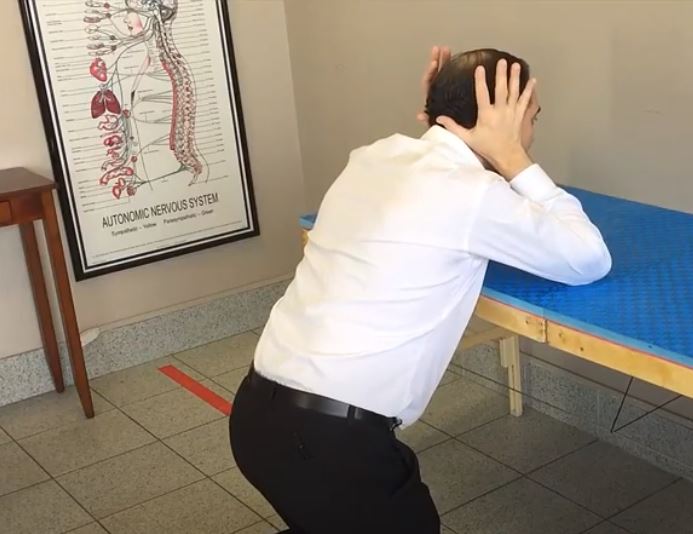
While supporting yourself, you are going to bring yourself back with your glutes and pull up towards the ceiling.
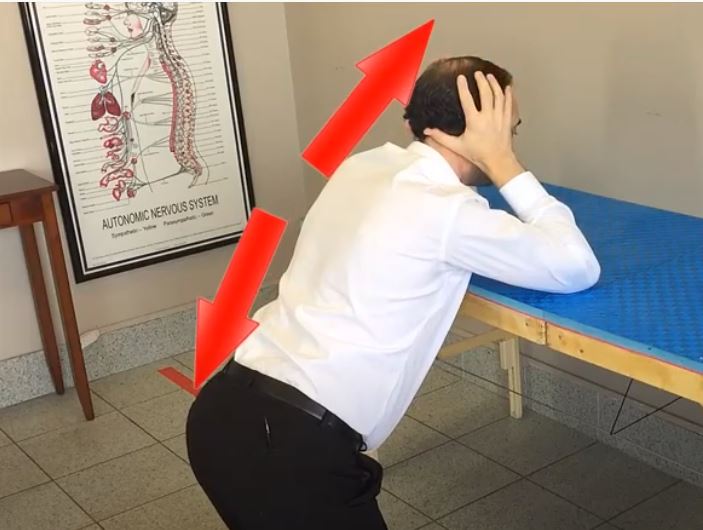
If you look up while doing this exercise, you will get a nice distraction effect in your neck. Grab a small face towel, fold it up and place it behind the skull, in replacement of your hands, and continue to pull back as you pull your head forward and look up. Hold in this position for 30 seconds to 2 minutes, at your tolerance and then release. Take a break for a minute or two, and repeat the exercise.
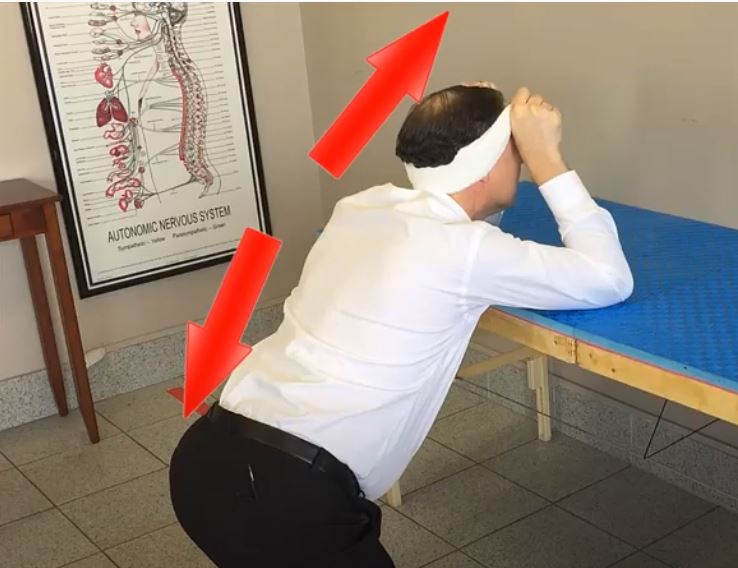
You will get nice relief in the cervical neck, in the suboccipital muscle and possibly in the arms, if you are having any arm symptoms. This first decompression technique, is specifically for the neck, the cervical spine, and there can be many reasons it needs to be decompressed. There could be a loss of alignment, a disc bulge or herniation in the neck, degeneration or loss of height of those disks, like thinning of the discs. When the neck is distracted, whether it is by your hand pulling up, or by the towel behind the skull, you are trying to separate those disc spaces and relieve the pressure.
Most times the pressure occurs because the head position sits on the spine, and if it was out of position or out of alignment it causes abnormal weight and load on the spine. When you apply a decompression technique, it separates the bottom and top part of the cervical spine which is very helpful. This decompression technique also helps to remove the pressure and the pinching on those nerves allowing this technique to not only be useful for neck pain but for numbness and tingling to the fingers as well.
The second exercise is for the middle back. We are moving down the spine to get that full back, full spine decompression. You are going to need a a roll of toilet paper to use as a fulcrum point. This is good for a slouching posture, to decompress and open up that mid-back. Start by lying on the ground, as it is firmer. Place the toilet paper roll in the mid part of your thoracic area. This area of your mid back is the most hunched.
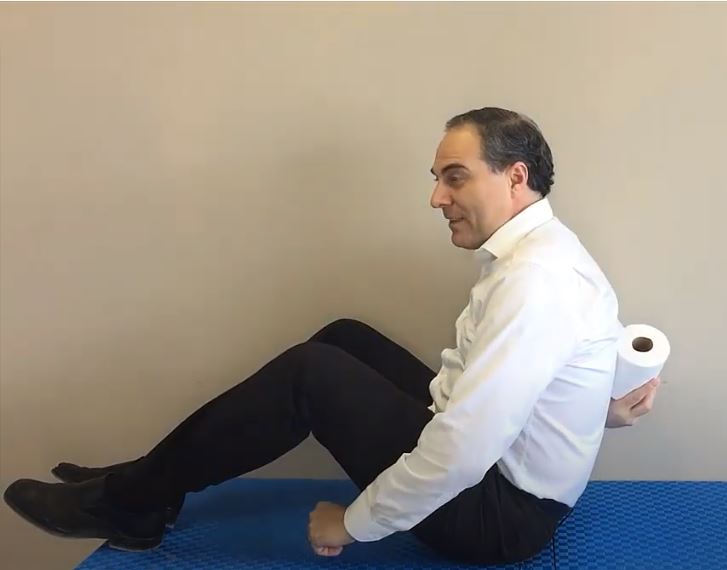
Ensure that you have some space and gently lean back on the roll. That creates a fulcrum point to help extend your back. If it is too flexed, lean back to your comfort and extend your legs. You will get a nice decompression effect in that middle thoracic area.

If you want more of a stretch and a decompression effect in that thoracic, mid back area, then bring your arms to your head.
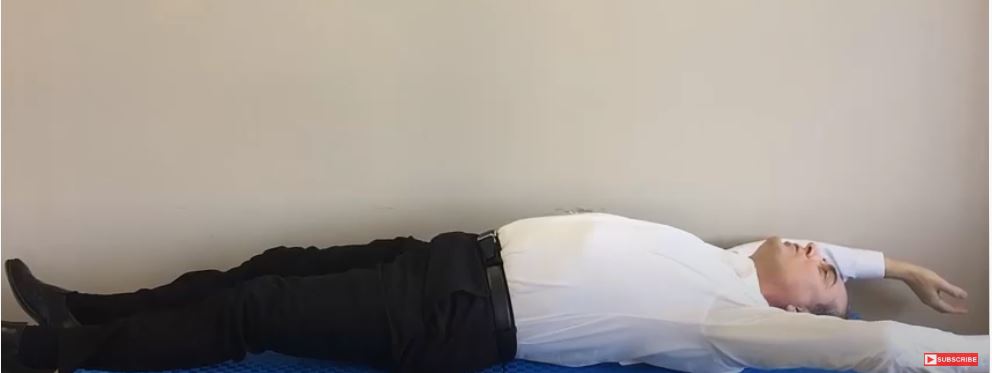
This technique focuses on the mid back area and is great for someone who has a hunching of the spine, that slouching posture that is very common today. That slouching posture compresses the discs abnormally at the front and irritates all the muscles at the back. When you create that fulcrum point by placing the toilet paper roll underneath, the spine is now unbending from that slouching position causing a decompression on those discs that were bending from that hunched back.
This is a very useful exercise to decompress that middle back area and reduce that slouching effect. Now the third decompression exercise to finish off the series in the full back decompression exercise, is for the lower back, the lumbar spine. We are going to get some extension in the lumbar spine, you may have seen the McKenzie extension or extending the back in a prone position, like the Cobra position. We’re going to add a bit more resistance in there to get more distraction, more decompression. Grab a bed sheet and fold it about five inches. Place it behind your back, on the lower part of your spine holding it with your hands.

Now you are going to get into an extension position. The bed sheet is going to help create some resistance.

Extend back more, as much as you can to get a nice decompression effect in that lower lumbar spine. You can also pull back down towards the feet and pull forward towards you hands, and extend to get an even better relieving effect.
You can hold that for 30 seconds, for a minute to two minutes, or you can do some repetitions like 10 seconds on and off. This third decompression exercise is for the lower back, the lumbar spine. The lumbar spine naturally should be curvy, it should have an elliptical curve. When there is a loss of curve, that can be a trigger or a causation for disc injury and disc bulges. Disc injury can also be from degeneration or compression of those discs. In this exercise, we had that bed sheet applied against the lower back, putting your spine into extension, which promotes that healthy curve in the lower back. So now the lumbar spine is extending. You are also pulling forward against the towel, and leaning back a little with the glutes giving you a nice extension, putting a gap in those disc spaces and relieving the pressure and irritation, not just on the actual disc, but as well on the nerves that may be compressed. That extension motion with that a bit of extra distraction to decompress the lower lumbar spine.
Those are great techniques that you can apply yourself at home. In the office, we do more advanced decompression techniques, but those are good things you can do. One of the reasons why people may be looking for relief in their lower back and to decompress their lower back, which is the lumbar spine is maybe because of an L4, L5 and L5, S1 disc bulge and associated symptoms like back pain and leg pain. There you have three great full spine decompression exercises.
Related Videos:
Here are some more spinal decompression exercise videos:
1) Best Exercise For L4 L5 Disc Bulge Best Exercise For L4 L5 Disc Herniation
2) Spinal Decompression Made Easy With Amazing (Pain Relieving) Results
3) How to Decompress Your FULL BACK for Instant Pain Relief

